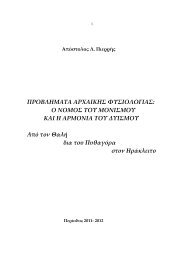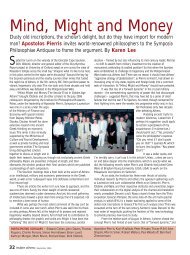APPENDIX C΄ ON DEPILATION: BODY COSMETICS IN CLASSICAL ...
APPENDIX C΄ ON DEPILATION: BODY COSMETICS IN CLASSICAL ...
APPENDIX C΄ ON DEPILATION: BODY COSMETICS IN CLASSICAL ...
You also want an ePaper? Increase the reach of your titles
YUMPU automatically turns print PDFs into web optimized ePapers that Google loves.
<strong>ON</strong> DEPILATI<strong>ON</strong>: <strong>BODY</strong> <strong>COSMETICS</strong> <strong>IN</strong> <strong>CLASSICAL</strong> ANTIQUITY 571<br />
answering exactly to Aristotle’s description. From what Eustathius says<br />
ad loc. (p. 1235.40 sqq.), it follows that many Alexandrian philologists<br />
did not perceive the point. Eustathius himself, on the other hand, after<br />
enumerating various emendations, correctly concludes: õÚÂÛÂÓ ÔsÓ âÓ<br />
ôÚıÚˇˆ ÁÚ¿ÊÂÈÓ (the question is about the ÙÔÜ in v. 252), «·åÂÙÔÜ<br />
̤ϷÓÔ˜, ÙÔÜ ıËÚËÙÉÚÔ˜», nÓ Î·d ÌÂÏ·Ó·›ÂÙÔÓ (Aristotle s ÌÂÏ·Ó¿Â-<br />
ÙÔ˜) ÙÈÓb˜ Û˘Óı¤Ùˆ˜ Ê·Û›, ÙeÓ Î·d Ê·ÛÛÔÊfiÓÔÓ, ÌÈÎÚeÓ Ì¤Ó, Ê·ÛÈÓ,<br />
ùÓÙ·, ÙáÓ ôÏÏˆÓ ‰b åÛ¯˘ÚfiÙÂÚÔÓ. K·Ïᘠ‰¤, Ê·ÛÈ, ÙeÓ ıËÚËÙÉÚ·<br />
ÙÔÜÙÔÓ àÂÙeÓ ó˜ ηd ÎÚ¿ÙÈÛÙÔÓ Î·d üÎÈÛÙÔÓ Âå˜ ÂåÎfiÓ· ÙÔÜ \A¯ÈÏ-<br />
Ϥˆ˜ ÂúÏËÊ (sc. ï appleÔÈËÙ‹˜) etc.<br />
The former species of eagle is clearly called after the whiteness of its<br />
rump-region, apple˘Á‹ + àÚÁfi˜. Thus when Aeschylus describes this type<br />
of eagle as Ù’ âÍfiappleÈÓ àÚÁĘ (Agamemnon, 115), the scholiast remarks:<br />
ï âÍÔapple›Ûˆ Ï¢Îfi˜, âÛÙÈÓ ï apple‡Á·ÚÁÔ˜. (The feature was so<br />
characteristic and picturesque that other animals too, were called<br />
accordingly; for a kind of antelope, cf. Herodotus IV, 192;<br />
Septuaginta, Deuteron. XIV, 5; Aelianus, Hist. Anim. VII, 19. For a<br />
kind of water bird, v. Aristotle, Hist. Anim. Θ, 593b5). This apple‡Á·Ú-<br />
ÁÔ˜ behaves badly towards its offspring (Aristotle, Hist. Anim., Z,<br />
563b5-6), kills fawns (öÓÈÔÈ ‰b ηÏÔÜÛÈÓ Ó‚ÚÔÊfiÓÔÓ ·éÙfiÓ, I,<br />
618b20), and, although it is the only species of eagle to be regularly<br />
found in plains, groves and even near the towns (ÔyÙÔ˜ ηÙa Ùa apple‰›·<br />
ηd Ùa ôÏÛË Î·d appleÂÚd Ùa˜ applefiÏÂȘ Á›ÓÂÙ·È... Ùa ‰b ÏÔÈapplea Á¤ÓË çÏÈÁ¿-<br />
ÎȘ Âå˜ apple‰›· ηd Âå˜ ôÏÛË ÊÔÈÙ÷Ä, 618b20-22), yet because of its bold<br />
and perhaps rash valour he flies also over mountainous regions and<br />
forests (apple¤ÙÂÙ·È ‰b ηd Âå˜ Ùa ùÚË Î·d Âå˜ ÙcÓ ≈ÏËÓ ‰Èa Ùe ı¿ÚÛÔ˜<br />
618b21). There is nothing fundamentally negative in this description,<br />
except the bird’s inattentiveness and perhaps harshness exhibited<br />
towards its offspring, and its implied overbearing and overstepping<br />
daring, its may be rather audacious valour (since it is not the strongest,<br />
and is more accustomed to the milder surroundings of the plains).<br />
Neither does Aeschylus wish to paint any negative picture for<br />
Menelaus when he clearly associates him to the apple‡Á·ÚÁÔ˜ eagle. Two<br />
eagles preyed on a pregnant hare, one ÎÂÏ·ÈÓfi˜ (the ÌÂÏ·Ó¿ÂÙÔ˜), the<br />
other âÍfiappleÈÓ àÚÁĘ (i.e. apple‡Á·ÚÁÔ˜), interpreted by Calchas as the two<br />
leaders of the Greek army falling upon Troy. Agamemnon 109 sqq.:<br />
¬appleˆ˜ \A¯·ÈáÓ ‰›ıÚÔÓÔÓ ÎÚ¿ÙÔ˜, ^EÏÏ¿‰Ô˜ ≥‚·˜<br />
͇ÌÊÚÔÓ· Ù·Á¿Ó,










